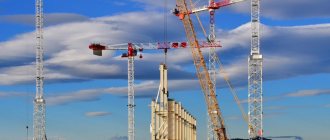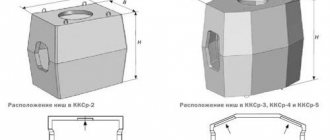Crawler cranes catalog
includes self-propelled jib cranes from leading Russian and world manufacturers, brands - Liebherr, XCMG, Sany, Kobelco (Kobelko), Manitowoc, Zoomlion (Zumlion), Hitachi, Terex, Sumitomo, XCMG and indices RDK, DEK, MKG, MKGS , SKG. Cranes of this type are distinguished by the presence of a crawler, a lattice-type boom with a set of inserts, additional attachments to increase the space under the boom in the form of light jibs (extensions) with the ability to adjust the angle of inclination and tower-boom equipment. Crawler cranes are used for installation work at the zero cycles of construction, installation of technological equipment, including unique ones, and caterpillars allow you to move around an unprepared construction site without any problems. The load-altitude characteristics of crawler cranes allow lifting loads weighing more than 1000 tons to a height of about 300 meters. Large crawler cranes are delivered to construction sites disassembled on heavy semi-trailers. Assembly is done on site by experienced mechanics. After completing the planned lifting operations, they are returned to the base. Manufacturers' address cards are located on the "PLANTS" tab. Crawler Cranes Photo Crawler Cranes Crawler Crane Specifications KOBELCO Crawler Cranes Manitowoc Crawler Crane China Sany Crawler Cranes Sennebogen Crawler Jib Cranes China XCMG Crawler Cranes China Zoomlion Crawler Cranes MGK Crawler Crawler Jib Cranes Crawler Jib Cranes DEC
CRANE SELECTION METHODOLOGY
Installation of reinforced concrete structures is a complex process consisting of simple processes and operations: slinging, lifting and installation of structures in the design position, alignment and temporary fixing, welding, embedding of joints, etc.
The leading machine that determines the overall productivity and duration of the construction of the building is the assembly crane.
The main data for choosing the type of erection cranes are: the configuration and dimensions of the building, dimensions, degree of enlargement, mass and location of the elements to be mounted, the volume and deadlines for performing the installation work, and the conditions for the production of work. Mounting cranes are selected depending on their lifting capacity, boom reach and lifting height of the crane hook.
The lifting capacity of the crane , when determining the reach of the boom, must correspond to the mass of the heaviest prefabricated elements and lifting devices.
With a significant amount of installation work and the installation of a large number of dissimilar elements that differ in weight and overall dimensions, it is advisable to provide several mounting cranes.
The outreach of the crane boom is determined depending on the configuration and dimensions of the building, taking into account the location of the mounted elements before installation and in the design position. In this case, it is necessary to take into account the dimensions of the storage area for prefabricated elements and the width of the paths for supplying elements for installation.
The lifting height of the crane hook above the crane parking level is determined by the position of the mounted elements and their height dimensions, taking into account the dimensions of the gripping devices (traverse, slings, etc.), as well as taking into account the safety margin for installation. The distance from the lower edge of the mounted element to the support before starting its installation should be within 0.5–1 m.
For unloading prefabricated structures arriving at the construction site, the project should provide for cranes of a lower carrying capacity (3–5 tons) with a reach of 7–10 m.
Assembly cranes may be used when unloading vehicles only when they are not performing assembly work.
Installation of prefabricated structures of the zero cycle, foundation pads, blocks of basement walls, etc., depending on the location of the erection crane in relation to the pit and the conditions of work, can be carried out from the edge or the bottom of the pit.
When assembling zero-cycle structures, the crane must have an insignificant outreach (7–10 m), a low hook lifting height (4–5 m) and a lifting capacity of 3–5 tons. For these conditions of production of installation work, jib cranes on caterpillar or pneumatic wheels are most suitable, which do not require the construction of expensive rail tracks and are economical in operation. When choosing caterpillar and pneumatic wheeled cranes, one should take into account the ways of their movement during the installation of the underground part of the building: along the pit along its edge, along the bottom of the pit, or in a combined way.
Installation of prefabricated elements of the above-ground part of a multi-storey building with a height of up to 4 floors is advisable to be carried out with caterpillar and pneumatic wheel jib cranes, and over 5 floors with tower cranes.
When choosing cranes, you should choose those models that meet the requirements of the installation process, have the lowest landing speeds and self-assemble on the construction site.
In the case of erecting a building of complex configuration in plan or during the installation of a number of buildings, when it is necessary to move the crane along a curved section of the track, cranes with special equipment for moving along a curved rail track should be taken.
Schemes of buildings with the placement of ways to move the assembly cranes are shown in Figures 1–4.
Figure 1 - Technological schemes for the installation of building frames using tower-jib and jib cranes
Figure 2 - Schemes of the location of tower cranes during the installation of multi-storey frame buildings: a) - with one crane; b) - two taps on opposite sides
Figure 3 - Schemes for the production of installation work using:
a) - jib crane; b) - two tower cranes.
Figure 4 - Installation of the building frame: a) - jib, b) - gantry cranes
A decisive influence on the choice of an erection crane is exerted by the mass of structures and devices to be mounted (slings, traverses, grabs, etc.), which are lifted together during the installation process.
The mounting mass of the structure is calculated by the formula:
, (1)
Where:
— weight of the structure, t;
- total mass of mounting devices, t.
Characteristics of mounting devices are given in appendices 3, 4.
The main parameters of mounting cranes are the lifting capacity at a certain reach of the boom and the lifting height of the hook.
When choosing a crane for mounting the underground part of the building from the edge of the excavation (Fig. 5), the minimum outreach of the mounting crane is determined as the sum of the distance from the axis of the far outermost wall of the building to the axis of the crane:
, (2)
where: r
— minimum reach of the crane boom;
b
- crane track width;
f
- the distance from the edge of the pit to the nearest support of the crane running gears (wheels, caterpillars) is taken from 1 to 1.5 m
;
c-
horizontal projection of the slope of the pit;
d-
foundation width;
b
- the distance between the inner faces of the foundations.
Figure 5 - Installation of structures of the zero cycle from the edge of the pit
When installing zero-cycle structures with a crane located at the bottom of the pit (Fig. 6), it is not necessary to use a boom with a long reach, therefore, in this case, cranes with a lower lifting capacity are used than when mounting from the edge of the pit.
Figure 6 - Installation of structures of the zero cycle from the pit.
The outreach of a crane located in a pit is determined by formula 3.
, (3)
It is advisable to install multi-storey buildings up to 5 floors high with caterpillar and pneumatic wheel jib cranes after backfilling and compacting the sinuses of the foundations of the underground part of the building. The outreach of the mounting crane is determined by the formula (2).
When mounting columns of frame-panel buildings with a height of up to 5 floors, in addition to the outreach of the boom of crawler and pneumatic wheel cranes, the required length of the crane boom is determined by the formula:
, (4)
where: H -
mark of the upper edge of the mounted structure;
h2-
the required additional lifting height of structures above ground level and the landing bridge;
- distance from the base of the crane to the boom support (1200-2100 mm);
- distance from the top of the mounted structure to the axis of the upper block of the boom;
α - boom angle in degrees
The required boom length for the installation of crossbars and floor slabs of frame-panel buildings (Fig. 7), (Fig.
(5)
where: b
- the length of the crossbar or floor slab;
c-
horizontal distance from the axis of the crane boom to the edge of the mounted structure (C = 1.5 m).
The value of the angle α is determined by the value of its tangent, which is calculated by the formula:
(6)
The obtained value of the angle α is substituted into the formula (5) and the required value of the length of the crane boom is determined.
If the length of the crane boom obtained for the installation of crossbars and slabs is greater than the required length of the boom for the installation of columns, then the crane with the largest boom length is accepted for the installation of structures.
For the installation of floor panels and crossbars of frame-panel buildings, cranes equipped with an arrow with a “jib” are often used (Fig. 9).
The required jib length is determined by the formula:
(7)
where: D
- the length of the jib in meters,
β is the angle between the boom and jib axes ( .
Figure 7 - Determining the required boom length when installing crossbars and girders
Figure 8 - Determining the required length of the crane boom when installing floor slabs
Figure 9 - Determining the required length of the crane jib
When installing building structures over 5 floors, tower cranes are used (Fig. 10.11).
When erecting multi-storey buildings, it is recommended to use tower cranes. Depending on the size of the building, rail-mounted cranes (for linearly extended multi-section buildings) or attachment cranes (for single-section buildings) can be used.
When erecting low-rise buildings, it is advisable to use self-propelled crawler or pneumatic wheel jib cranes.
On fig. 10 shows schemes for the construction of buildings using various methods of installing cranes. In the case of a one-sided installation (diagram in Fig. 10, a), the tower crane coverage area covers the entire width of the building, which requires the use of more powerful cranes; when using two cranes located on opposite sides of the building under construction (scheme in Fig. 10, b), the coverage area of each of the cranes must cover at least half the width of the building. In the case of the construction of high-rise, "point" buildings, the schemes shown in Fig. 10, in, g.
Figure 10 - Schemes for installing cranes during the construction of buildings with a monolithic
frame:
a) - one-sided; b) - bilateral; c) - attached crane from the outside of the building; d) - attachment crane in the core of the building stiffness
Figure 11 - Scheme for determining the parameters of tower cranes. An example of increasing the height of a self-elevating stationary crane, depending on the increase in the number of floors
The choice of cranes in the construction of monolithic and precast-monolithic buildings is carried out in two stages.
At the first stage, the necessary technical parameters of cranes are determined: lifting capacity, boom reach, hook lifting height (Fig. 11); further, according to the reference literature, several options for cranes are selected, the operating parameters of which are equal to or slightly greater than those required.
The maximum lifting height of a tower crane hook is determined by the formula:
, (8)
Where
– distance from the level of the crane parking (the top of the rail head of the crane track) to the geometric center of the hook link, m;
- the level of the upper mounting horizon, m;
- the headroom when lifting the load above the highest obstacle, is taken equal to 0.5 m; - the highest of the heights of the lifted loads (hopper with concrete mixture, formwork panel or block, reinforcing cage, prefabricated mounting element), m;
- the estimated height of the sling, m, is determined according to form 6.
When determining the maximum lifting height of the crane hook for buildings erected in collapsible or block formwork, removed upwards, it is necessary to take the mark of the top of the monolithic structure of the wall of the last floor of the building as the level of the upper mounting horizon.
Crane outreach L, m, is determined by the formula
, (9)
Where
– crane runway width, m;
- distance from the crane rail closest to the building to the nearest protruding part of the building, m;
- distance from the center of gravity of the load to the most protruding part of the building, m.
When erecting a building in panel and block formwork, the value of c is taken equal to the width of the building (with cranes located on one side of the building) or at least half the width of the building (for cranes located on opposite sides of the building). In the case of using a floating formwork or "canteen" formwork of floors when working with one crane, half the length of the formwork structure +2 m must be added to the width of the building.
Since at this stage of the calculation the brand of the crane that will be accepted for the production of work is not known, the value can be taken equal to the width of the crane runway of any of the cranes of the required load capacity, and then clarified after selecting a specific crane. The value also depends on the design of a particular crane, so at this stage of the calculation can be taken:
- for cranes with a rotary tower and a counterweight located above the building - 2 m;
- for cranes with a slewing tower and a counterweight located at the bottom - equal to the radius of the slewing part minus , and plus 1 meter - to ensure the required width of the crane working area.
The required lifting capacity of the crane is equal to the sum of the mass of the lifted load and the mass of the lifting device:
, t, (10)
Where
- mass of the lifted load (panel or formwork block, reinforcing cage, prefabricated assembly element), t;
- weight of the rigging device, taken from table 8.
For concrete hopper
, (11)
Where
– nominal capacity of the bunker, m3;
– volumetric mass of concrete, taken equal to 2.4 t/m3 for heavy concrete, 1.8 t/m3 for expanded clay concrete;
- dead weight of the bunker, t.
It should also be borne in mind that, as a rule, carriage cranes should be used to dismantle the large-panel formwork of ceilings and volumetric-climbing formwork. When using adjustable distribution booms or a mechanical distributor for the supply of concrete, the need to lift and rearrange them with a crane should be taken into account, i.e. The lifting capacity of the crane must be greater than the mass of the switchgear.
At the second stage, by economic comparison of the selected options, the most effective one is determined.
A graphical way to determine the reach of an arrow. The outreach of the erection cranes can be determined graphically (Fig. 12).
Figure 12 - Determining the outreach of the crane boom in a graphical way:
a) - for an arrow without a jib, b) - for an arrow with a jib.
To do this, at a height of 1.5 m
from the level of the crane parking, a line is drawn for the location of the heel of the boom of the crane NN, and on the axis of the location of the structure or part in the building being mounted EE1, a point is found for the possible location of the upper block of the boom D, D ', D ". A straight line connects the point of the boom block and points A, B, which define the boundaries of maximum approximation
the axis of the boom to the contour of the building, which must be at least 1.5 m from the building, i.e. a \u003d b \u003d 1.5 m.
The continuation of a straight line to the point of its intersection with a straight line, taking into account the level of location of the lower heel of the boom
C
from the level of the crane parking lot, will be the length of the crane boom L, and the horizontal projection of this straight line will determine the required reach of the crane boom
r.
When mounting structures with a crane, the boom of which is equipped with a jib, to determine the required outreach of the boom on the axis of the structure to be mounted, the point of the possible location of the upper boom block is determined. At the level of this point, a horizontal line is drawn, on which the length of the goose is laid.
Further determination of the required boom reach is carried out in the same order as for an arrow without a jib.
If the estimated length of the crane boom is equal to or less than the boom length specified in the technical specification, then this crane can be used for the installation of this building. The calculation must be made for the prefabricated element furthest from the crane and located at the maximum height.
Previous2Next
Conflicts in family life. How to change it? A rare marriage and relationship exists without conflict and tension. Everyone goes through this...
What Causes Trends in the Stock and Commodity Markets Freight Train Theory Explained The first 17 years of my market research consisted of trying to figure out when this...
What will happen to the Earth if its axis shifts by 6666 km? What will happen to the Earth? I asked myself...
What if there is no reciprocity? Now let's get down to earth. Landed? We continue the conversation...
Didn't find what you were looking for? Use the Google search on the site:





